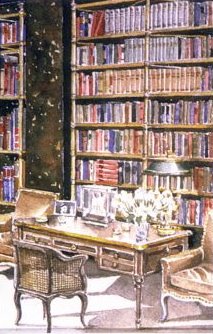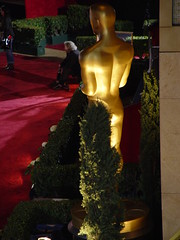Since we're interested in carpet of all kinds here at The Carpetology Blog, it would be a shame to let the biggest red carpet awards show of the year slip through our fingers without recognizing Hollywood's impact on design. Sunday night, February 24, was the 80th annual Academy Awards, perhaps the biggest event in the entertainment industry until it rolls out again next year.
Somehow, in spite of the number of red carpet events throughout the year, the Oscars still exude the very essence of glamour and Old Hollywood sophistication. This is the night the movie stars come out -- not the over-hyped celebrities with their purse puppies. The Academy Awards have a rich tradition dating back to 1929 that includes the most esteemed and talented individuals in the motion picture industry. Visit both Oscars.com and Oscars.org for the history of the Academy and its most glamorous event. [For more Oscar trivia try filmsite.org, a site that film critic Roger Ebert has often referenced in his critiques. It's full of delicious Oscar facts, including Academy Awards winners by decades and years, movie posters, quotes and trivia.]
Below: Bette Davis on the red carpet at the Academy Awards in 1936. Photo courtesy of Oscar.com. 
Although the true glamour of Old Hollywood rarely makes an appearance these days, there are a few people who still make an effort to keep it alive. Kelly Wearstler, a high-end interior designer, was recently featured in Hollywood Regency Style Walks the Red Carpet in Today’s Polished Interiors, an article by Stacy Downs of the Kansas City Star. All about the "Hollywood Regency" style of design, Wearstler gets Hollywood glamour.
Below: a watercolor by decorator Mark Hampton of a library designed by Billy Baldwin for Cole Porter. Classic Hollywood Regency! Originally uploaded by Style Court.
When I first read the article, I wasn't familiar with the term 'Hollywood Regency'. But when you read its descriptions and visit Kelly's Web site, you're instantly transported to an earlier time, when slender cigarette holders were the height of sophistication, Edith Head still designed costumes, and people knew that MGM stood for the venerable film studio of Metro Goldwyn Mayer. For visual cues, think movies like the Thin Man series or Rebecca.
Characterized by such accents as animal hides, art deco furniture, lacquered finishes and baroque frames, Hollywood Regency is a blend of 1930s movie star glamour, mod graphics, and a "dash of bold whimsy," according to the article. "Broken down, 'Hollywood' is the ornate, glamorous part of the style. 'Regency' refers to the architectural period of the early 1800s, a return to classic lines such as Greek columns."
HGTV's blog, Design Happens, describes Hollywood Regency as it would a woman: "A more justified summation of her aesthetic would be to refer to her as a 'lifestyle' rather than simply a 'look-of-the-moment, 'Hollywood Regency embodies a spirit of living rather than the return to a specific type of design or a specific point in time. She's a way of life where people are truly living in the moment, and not distracted with text-messaging during dinner, or living a life where quality time together equates to quiet time in front of a television during premiere week."
It sounds luxurious in a comfortable sort of way, does it not?
The Kansas City Star article reminds us not to forget Dorothy Draper, William Haines and Billy Baldwin, all interior designers from the 1920s and 1930s whose work defined Hollywood Regency. [William Haines was actually a movie star before becoming an interior designer.] Each of these designers helped to transition the look of the time from heavy and dark to new and fresh, completely altering how people perceived interior design.
A William Haines room from William Haines Design. Photo courtesy of HGTV.com.
Needless to say, the spirit of Old Hollywood is alive and well - in design!
~Elizabeth
Technorati Tags: Hollywood Regency interior design Hollywood Red Carpet Oscars Hollywood's Impact on Design Del.icio.us Tags: Hollywood Regency interior design Hollywood Red Carpet Oscars Hollywood's Impact on Design






No comments:
Post a Comment